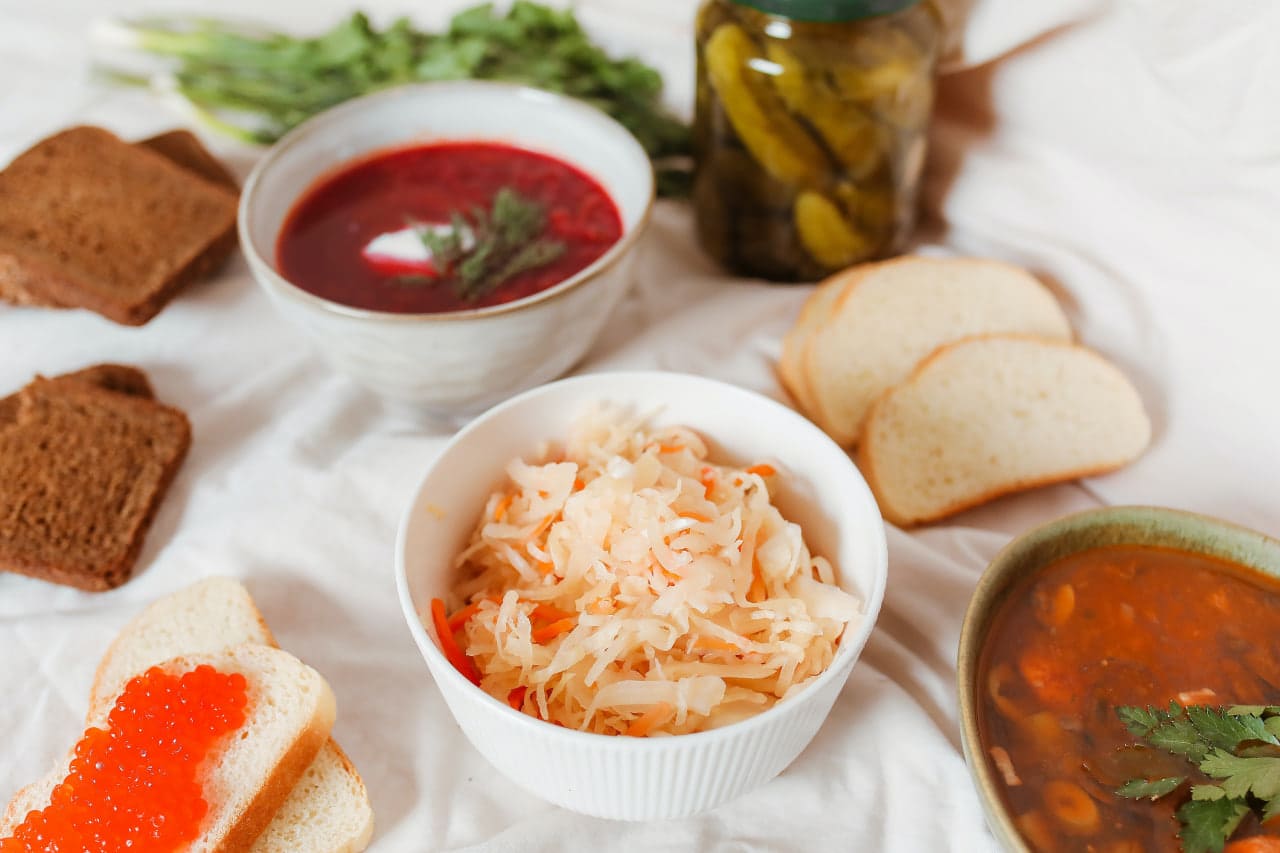
No-salt sauerkraut
Summary
Okay, so have you ever had that moment where you’re staring at a cabbage and thinking, “I wish I could ferment this without all that salt?” Well, the universe has heard you! Let’s introduce you to the wonders of No-salt sauerkraut, minus the sodium overload. It’s healthy, it’s tangy, and it’s pretty much homemade brilliance.
The Ingredients You’ll Need
- Some fresh cabbages – Let’s say about 2 heads (or for those number lovers, around 5 pounds or 2.3 kg)
- A decent amount of filtered water
- Caraway seeds, if you’re into them – Just a tablespoon (or 15 ml) should do
Time Check
- Getting it all together: Roughly 20 minutes
- Playing the waiting game (fermentation): About 14 loooong days
Portion Check
For a group of 6-8 hungry folks
What’s the Damage? (Nutrition)
- Calories: 27 (Not bad, huh?)
- Carbs: A modest 6.1g
- Protein: 1.3g (Every bit counts!)
- Fat: A minuscule 0.2g
- Fiber: A decent 2.9g
- Sugars: 3.1g (Nature’s candy!)
Alright, Let’s Get This Sauerkraut Party Started!
- First things first, wash those hands! And, yeah, whatever you’re using too.
- Let’s strip that cabbage! But hey, save those outer leaves. We’ll need ’em.
- Get to shredding! The finer, the better.
- Grab a big bowl. Throw in the cabbage and the seeds. Mix it up!
- Squeeze that cabbage. No, really, squeeze it till it’s juicy.
- Now, pack that juicy mix into a jar. Make it snug.
- Push it down; let the liquid rise above.
- Those outer leaves you saved? Time to shine! Place them on top.
- A little low on liquid? Top it off with some water.
- Put a cloth or lid on, but let it breathe.
- Patience, my friend. 14 days in a cool, dark spot.
- Peek sometimes. If there’s mold, scoop it out. No harm, no foul.
- Once done, fridge it.
Some Tips Because We Care
- Fresh cabbage, always. No compromises.
- Clean everything. Like, everything.
- Cold room? Might take a while longer.
- Check the taste. Too tangy? Put it in the fridge.
- Smells weird? Trust your nose, toss it.
Hungry Yet? Serve it Up!
- It’s a killer side dish. Seriously.
- Toss it in a salad. Crunchy goodness? Check.
- Fermented foods? Add ’em in. It’s a gut-loving party.
- Sandwiches? Wraps? Yep, it fits right in.
Wrapping Up
So, No-salt sauerkraut isn’t just about the food. It’s an experience. Low-sodium, full-flavor, and a delightful addition to your culinary adventures. And remember, while fermenting is awesome, be safe and smart about it. Happy eating!
What is No-Salt Sauerkraut?
No-salt sauerkraut is a fermented cabbage dish that omits the traditionally used salt. It offers a tangy flavor while being low in sodium, making it a healthier alternative to the classic sauerkraut.
What Ingredients are Needed for this Recipe?
For the no-salt sauerkraut, you’ll need about 2 heads of fresh cabbages (approximately 5 pounds or 2.3 kg), filtered water, and an optional tablespoon of caraway seeds.
How Long Does the Preparation and Fermentation Take?
The preparation will take roughly 20 minutes. Fermentation, or the waiting game, will take about 14 days.
How Many Servings Does this Recipe Make?
This recipe is enough to serve a group of 6-8 hungry individuals.
What’s the Nutritional Content of No-Salt Sauerkraut?
A serving offers 27 calories, 6.1g of carbs, 1.3g protein, 0.2g fat, 2.9g fiber, and 3.1g natural sugars.
How Do I Ensure Proper Fermentation?
Ensure that the cabbage is packed snugly in a jar and is submerged under its juice or some added filtered water. Place a cloth or lid on top, but make sure it can still breathe. Store it in a cool, dark place for 14 days.
What if I See Mold During Fermentation?
Mold can sometimes form on the surface. It’s okay; simply scoop it out and continue with the fermentation process.
Any Tips for Best Results?
Always use fresh cabbage, and ensure everything used in the process is clean. If fermenting in a cold room, the process might take longer. Trust your senses; if the sauerkraut smells off, it’s best to discard it.
How Can I Serve No-Salt Sauerkraut?
No-salt sauerkraut can be enjoyed as a side dish, added to salads for a crunchy touch, combined with other fermented foods, or used as a filling in sandwiches and wraps.
Is No-Salt Sauerkraut Better Than Traditional Sauerkraut?
While both versions offer unique flavors and benefits, no-salt sauerkraut is particularly beneficial for those looking to reduce their sodium intake. However, always ensure you follow safety precautions when fermenting at home to enjoy its full benefits.

No-salt sauerkraut
Nutritions
Ingredients
- Some fresh cabbages – Let’s say about 2 heads or for those number lovers, around 5 pounds or 2.3 kg
- A decent amount of filtered water
- Caraway seeds if you’re into them – Just a tablespoon (or 15 ml) should do
- Time Check
Instructions
- First things first, wash those hands! And, yeah, whatever you’re using too.
- Let’s strip that cabbage! But hey, save those outer leaves. We’ll need ’em.
- Get to shredding! The finer, the better.
- Grab a big bowl. Throw in the cabbage and the seeds. Mix it up!
- Squeeze that cabbage. No, really, squeeze it till it’s juicy.
- Now, pack that juicy mix into a jar. Make it snug.
- Push it down; let the liquid rise above.
- Those outer leaves you saved? Time to shine! Place them on top.
- A little low on liquid? Top it off with some water.
- Put a cloth or lid on, but let it breathe.
- Patience, my friend. 14 days in a cool, dark spot.
- Peek sometimes. If there’s mold, scoop it out. No harm, no foul.
- Once done, fridge it.
Notes
Clean everything. Like, everything.
Cold room? Might take a while longer.
Check the taste. Too tangy? Put it in the fridge.
Smells weird? Trust your nose, toss it. It’s a killer side dish. Seriously.
Toss it in a salad. Crunchy goodness? Check.
Fermented foods? Add ’em in. It’s a gut-loving party.
Sandwiches? Wraps? Yep, it fits right in.


Leave a Reply